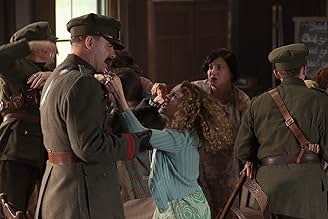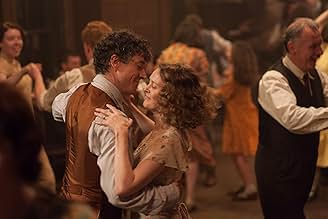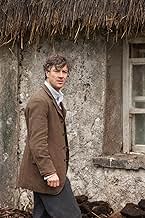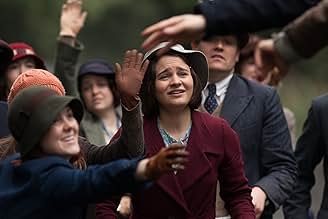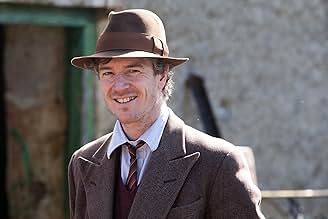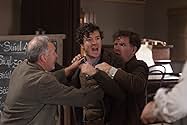Jimmy's Hall
- 2014
- Tous publics
- 1h 49min
Pendant la Dépression, Jimmy Gralton rentre chez lui en Irlande après dix ans d'exil en Amérique. Voyant les niveaux de pauvreté et d'oppression, l'activiste en lui cherche à rouvrir la sall... Tout lirePendant la Dépression, Jimmy Gralton rentre chez lui en Irlande après dix ans d'exil en Amérique. Voyant les niveaux de pauvreté et d'oppression, l'activiste en lui cherche à rouvrir la salle de danse qui a conduit à sa déportation.Pendant la Dépression, Jimmy Gralton rentre chez lui en Irlande après dix ans d'exil en Amérique. Voyant les niveaux de pauvreté et d'oppression, l'activiste en lui cherche à rouvrir la salle de danse qui a conduit à sa déportation.
- Réalisation
- Scénario
- Casting principal
- Récompenses
- 2 victoires et 3 nominations au total
Avis à la une
One flaw in the movie is that people assume the struggle between Jimmy and the priest is communism versus the church. But Jimmy was not a communist. Jimmy was a grass-roots liberal who supported his community and occasionally spoke out against the concentration of power. The church represents this concentration of power and the struggle to maintain the concentration of power.
During the 1920's, a large percentage of the world's "Wealth" was tied up in speculative investments. Corrupt politicians sided with the land holders and the "Robber barons". By 1924, economic experts started to announce that unfettered greed would lead to an economic crisis in the USA and Europe. In 1929, the US stock-market crash vaporized much of the world's wealth and centralized power among an even smaller percentage of the population.
The movie includes a lot of history that most people in the US and UK who were born before 1977 already know. However, for most of the world, the Irish history and the extent of the struggle between the rich and poor during those times is new.
This struggle continues today. Instead of hereditary land owners, we have large banks and other institutions that "influence" most of the world's "capitalist" governments. The government favors for corporations and privatization of government services that starting in the late 1970's continues to this day and is responsible for the depression of 2008.
Without government support for those who were thrown into poverty, the 2008 depression would have been as bad as the 1929 depression. I think the writers were trying to remind us about the consequences of unfettered greed.
The movie really got my blood boiling even if it was very quiet and slow pace, but it hit some interesting marks about tolerance and freedom of expression. A condition needed by every human. I'm use to seeing rebellions in which people get violent in their protest, but this movie was very tamed, but more importantly, still got the message across.
My favorite part of the movie is the cool Irish music that was featured in the movie.
I like it a lot.
It deals with the very specific conflict between those who opposed the Treaty, those who supported it and the dominating Catholic Church when one, Jimmy Gralton, returns from 10 years exile in America and reopens a community hall that was the source of all his trouble in the first place, against the express wishes of 'Holy Mother Church' and those who backed it.
As scripted by Paul Laverty it is, of course, a deeply political film but Loach is the most humanist of political film-makers; consequently it is also a deeply moving (and, at times, very funny) picture. At its centre is a magnificent performance from Barry Ward as Gralton and he is backed beautifully by Jim Norton and Andrew Scott representing the clergy as well as a host of wonderfully naturalistic Irish actors, some professional, some not. Loach may now be in this seventies but this feels as fresh and as relevant as anything he did fifty years ago. I think it's the equal to both "Land and Freedom" and "The Wind that Shakes the Barley".
What, indeed, could be wrong with opening a dance hall and cultural center? Well in the thirties Ireland was recovering from years of bloody conflict, first the war for independence, followed by more years of civil war. Father Sheridan argues that now is the time for reconciliation, not for political agitation, and what he sees as communist propaganda. It is time for being Irish together, for listening to Irish music rather than "alien Jazz from deepest Africa".
Of course the Loach's sympathy (and ours) goes to the yearning of the young people who have no place to go, no prospects, no jobs, and who desperately want to find some joy, relief and self-expression. The movie may be a bit slow at times, but it is deeply moving.
This film is naturally quite critical of the church's stranglehold on Irish life and policy. Jim Norton's role in portraying this is invaluable, after all who better to portray a controlling, traditionalist,angry priest than Bishop Brennan himself? Indeed, Jim's character in this film completely mirrors his character in Father Ted... but believe me, that is NOT a criticism.
While the movie may be slow-paced and seemingly dull at certain inter-sections, it's importance for history cannot be discounted. Not so long ago, it would have been sacrilege to watch this film due to it's unsubtle portrayal of the church's sometimes intrusive influence on Ireland, in fact some probably would still consider it to be so. It also deals with the rise of Fascism in Ireland in the early 20th century, something that is almost absent from cinema.
The movie deserves more credit and should have a larger influence than it appears to have. Give it a chance, some may call it propaganda... it's not. Give it a watch.
Le saviez-vous
- AnecdotesThe real Jimmy Gralton was the only Irishman ever deported from Ireland after Irish Independence. After the release of the film, a 2015 campaign (including an online petition) was started with the aim to rescind the deportation order and extend an official apology to his family. In 2016, this resulted in the President of Ireland stating the only deportation of an Irishman from Ireland was "wrong and indefensible." He unveiled a Gralton memorial at Effrinagh outside Carrick-on-Shannon, on the site where the hall once stood. The stone edifice, which tells Gralton's life story as a labor campaigner, was partially funded by the trade union movement.
- GaffesTobacco consumption (cigarettes, snuff and pipes) was extremely widespread at the time, yet none of the characters are seen to smoke, even at raucous social occasions.
- Citations
James Gralton: We need to take control of our lives again. Work for need, not for greed. And not just to survive like a dog, but to live. And to celebrate. And to dance, to sing, as free human beings.
- Crédits fousAt the end of a long list of people and organizations under the heading "Thank You" in the end credits, Dixie the horse, Cabundie the donkey, and Homer the three-legged dog are mentioned.
- ConnexionsFeatured in La noche de...: Jimmy's Hall (2017)
- Bandes originalesSugar Foot Strut
Written by Harry Myers, Billie Pierce, Charles Schwab, Georges Matis
Used by kind permission of Carlin Music Corp.
Performed by Louis Armstrong & His Savoy Ballroom Five
courtesy of Sony Music Entertainment Inc.
Meilleurs choix
- How long is Jimmy's Hall?Alimenté par Alexa
Détails
- Date de sortie
- Pays d’origine
- Sites officiels
- Langues
- Aussi connu sous le nom de
- Özgürlük Dansı
- Lieux de tournage
- Killanummery, Co. Leitrim, Irlande(Jimmy's Hall and surroundings)
- Sociétés de production
- Voir plus de crédits d'entreprise sur IMDbPro
Box-office
- Budget
- 6 911 962 € (estimé)
- Montant brut aux États-Unis et au Canada
- 560 592 $US
- Week-end de sortie aux États-Unis et au Canada
- 19 881 $US
- 5 juil. 2015
- Montant brut mondial
- 4 825 184 $US
- Durée
- 1h 49min(109 min)
- Couleur
- Mixage
- Rapport de forme
- 1.85 : 1



